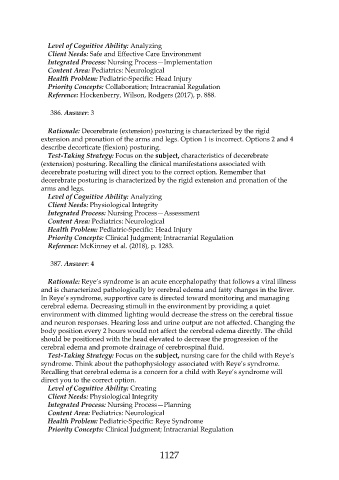Page 1127 - Saunders Comprehensive Review For NCLEX-RN
P. 1127
Level of Cognitive Ability: Analyzing
Client Needs: Safe and Effective Care Environment
Integrated Process: Nursing Process—Implementation
Content Area: Pediatrics: Neurological
Health Problem: Pediatric-Specific: Head Injury
Priority Concepts: Collaboration; Intracranial Regulation
Reference: Hockenberry, Wilson, Rodgers (2017), p. 888.
386. Answer: 3
Rationale: Decerebrate (extension) posturing is characterized by the rigid
extension and pronation of the arms and legs. Option 1 is incorrect. Options 2 and 4
describe decorticate (flexion) posturing.
Test-Taking Strategy: Focus on the subject, characteristics of decerebrate
(extension) posturing. Recalling the clinical manifestations associated with
decerebrate posturing will direct you to the correct option. Remember that
decerebrate posturing is characterized by the rigid extension and pronation of the
arms and legs.
Level of Cognitive Ability: Analyzing
Client Needs: Physiological Integrity
Integrated Process: Nursing Process—Assessment
Content Area: Pediatrics: Neurological
Health Problem: Pediatric-Specific: Head Injury
Priority Concepts: Clinical Judgment; Intracranial Regulation
Reference: McKinney et al. (2018), p. 1283.
387. Answer: 4
Rationale: Reye’s syndrome is an acute encephalopathy that follows a viral illness
and is characterized pathologically by cerebral edema and fatty changes in the liver.
In Reye’s syndrome, supportive care is directed toward monitoring and managing
cerebral edema. Decreasing stimuli in the environment by providing a quiet
environment with dimmed lighting would decrease the stress on the cerebral tissue
and neuron responses. Hearing loss and urine output are not affected. Changing the
body position every 2 hours would not affect the cerebral edema directly. The child
should be positioned with the head elevated to decrease the progression of the
cerebral edema and promote drainage of cerebrospinal fluid.
Test-Taking Strategy: Focus on the subject, nursing care for the child with Reye’s
syndrome. Think about the pathophysiology associated with Reye’s syndrome.
Recalling that cerebral edema is a concern for a child with Reye’s syndrome will
direct you to the correct option.
Level of Cognitive Ability: Creating
Client Needs: Physiological Integrity
Integrated Process: Nursing Process—Planning
Content Area: Pediatrics: Neurological
Health Problem: Pediatric-Specific: Reye Syndrome
Priority Concepts: Clinical Judgment; Intracranial Regulation
1127

